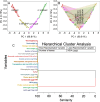Synergistic effects of boron and saponin in mitigating salinity stress to enhance sweet potato growth
- PMID: 38844823
- PMCID: PMC11156973
- DOI: 10.1038/s41598-024-63840-z
Synergistic effects of boron and saponin in mitigating salinity stress to enhance sweet potato growth
Abstract
Salinity stress significantly hinders plant growth by disrupting osmotic balance and inhibiting nutrient uptake, leading to reduced biomass and stunted development. Using saponin (SAP) and boron (B) can effectively overcome this issue. Boron decreases salinity stress by stabilizing cell walls and membranes, regulating ion balance, activating antioxidant enzymes, and enhancing water uptake. SAP are bioactive compounds that have the potential to alleviate salinity stress by improving nutrient uptake, modulating plant hormone levels, promoting root growth, and stimulating antioxidant activity. That's why the current study was planned to use a combination of SAP and boron as amendments to mitigate salinity stress in sweet potatoes. Four levels of SAP (0%, 0.1%, 0.15%, and 0.20%) and B (control, 5, 10, and 20 mg/L B) were applied in 4 replications following a completely randomized design. Results illustrated that 0.15% SAP with 20 mg/L B caused significant enhancement in sweet potato vine length (13.12%), vine weight (12.86%), root weight (8.31%), over control under salinity stress. A significant improvement in sweet potato chlorophyll a (9.84%), chlorophyll b (20.20%), total chlorophyll (13.94%), photosynthetic rate (17.69%), transpiration rate (16.03%), and stomatal conductance (17.59%) contrast to control under salinity stress prove the effectiveness of 0.15% SAP + 20 mg/L B treatment. In conclusion, 0.15% SAP + 20 mg/L B is recommended to mitigate salinity stress in sweet potatoes.
Keywords: Antioxidant activity; Boron; Chlorophyll content; Photosynthetic rate; Saponin; Sweet potato.
© 2024. The Author(s).
Conflict of interest statement
The authors declare no competing interests.
Figures








Similar articles
-
Combined effect of gallic acid and zinc ferrite nanoparticles on wheat growth and yield under salinity stress.Sci Rep. 2024 Jun 4;14(1):12854. doi: 10.1038/s41598-024-63175-9. Sci Rep. 2024. PMID: 38834735 Free PMC article.
-
Potential of kaempferol and caffeic acid to mitigate salinity stress and improving potato growth.Sci Rep. 2024 Sep 17;14(1):21657. doi: 10.1038/s41598-024-72420-0. Sci Rep. 2024. PMID: 39294197 Free PMC article.
-
Effects of cadmium stress on the growth and physiological characteristics of sweet potato.BMC Plant Biol. 2024 Sep 10;24(1):850. doi: 10.1186/s12870-024-05551-1. BMC Plant Biol. 2024. PMID: 39256706 Free PMC article.
-
Foliar application of glycinebetaine regulates soluble sugars and modulates physiological adaptations in sweet potato (Ipomoea batatas) under water deficit.Protoplasma. 2020 Jan;257(1):197-211. doi: 10.1007/s00709-019-01429-4. Epub 2019 Aug 12. Protoplasma. 2020. PMID: 31407117
-
Combined Boron Toxicity and Salinity Stress-An Insight into Its Interaction in Plants.Plants (Basel). 2019 Sep 23;8(10):364. doi: 10.3390/plants8100364. Plants (Basel). 2019. PMID: 31547605 Free PMC article. Review.
Cited by
-
Mitigation of salinity stress via improving growth, chlorophyll contents and antioxidants defense in sunflower with Bacillus pumilis and biochar.Sci Rep. 2025 Mar 20;15(1):9641. doi: 10.1038/s41598-025-93959-6. Sci Rep. 2025. PMID: 40113844 Free PMC article.
-
Synergistic Effect of Exogenous Application of Proline and Boric Acid on the Growth, Physiological Aspects, and Postharvest Quality of Radish under Salt Stress.ACS Omega. 2025 Jul 21;10(29):31801-31811. doi: 10.1021/acsomega.5c03010. eCollection 2025 Jul 29. ACS Omega. 2025. PMID: 40757358 Free PMC article.
-
Bio-Based Surfactants and Biosurfactants: An Overview and Main Characteristics.Molecules. 2025 Feb 13;30(4):863. doi: 10.3390/molecules30040863. Molecules. 2025. PMID: 40005173 Free PMC article. Review.
References
-
- Paz AM, et al. Salt-affected soils: Field-scale strategies for prevention, mitigation, and adaptation to salt accumulation. Ital. J. Agron. 2023 doi: 10.4081/ija.2023.2166. - DOI
-
- Naorem A, et al. Soil constraints in an arid environment—Challenges, prospects, and implications. Agronomy. 2023;13:220. doi: 10.3390/agronomy13010220. - DOI
-
- Milani, M. H., Feyzi, H., Ghobadloo, F. C., Gohari, G. & Vita, F. Recent advances in nano-enabled agriculture for improving plant performances under abiotic stress condition., in EngineeredNanoparticlesinAgriculture:FromLaboratorytoField, 197 (2023).
-
- Abdoli M. Effects of micronutrient fertilization on the overall quality of crops. In: Aftab T, Hakeem KR, editors. Plant Micronutrients Deficiency and Toxicity Management. Springer; 2020. pp. 31–71.
MeSH terms
Substances
LinkOut - more resources
Full Text Sources
Miscellaneous

